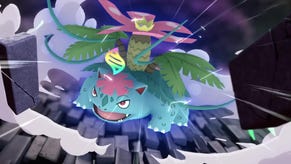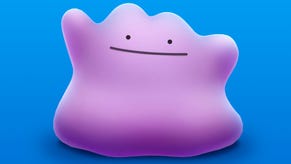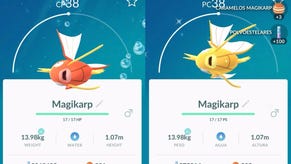Pokémon Go's raid update captures a fresh lease of life
Worth a second Chancey.
It's been a year since Pokémon Go launched and become the kind of global phenomenon other games dream about. Kids played it, adults played it. I played it quite a bit. Here in the office, we'd go eat lunch in the park with our phones out, spinning the nearby Pokéstops and calling out nearby spawns. "Anyone need a Diglett?" "Dratini!" "Just another Zubat." Pokémon Go was everywhere - on US chat shows, on The Simpsons, on Donald Trump's Twitter. Even Jeremy Corbyn had a go.
The game's enormous popularity last summer was always going to be a difficult act to follow. How do you compete with the game's initial launch, when everyone was off capturing their first creatures? How do you recapture that first sense of adventure, when the craze became a cultural phenomenon? Pokémon Go's big February update, which added 100 more monsters, was one answer to that. Simply having more Pokémon will always keep some people coming back. Another answer was simply to shore up the app itself. It's easy to forget now, but Pokémon Go's own stability would frequently prove the biggest barrier to getting playing.
This summer, Pokémon Go hasn't added any new Pokémon. It hasn't even unlocked Legendary creatures (yet). But it has added a completely new type of gameplay - raids - which have gotten me playing once more. The idea of raids initially made me think of Destiny, of the need to actively find a group of players to team up with to have any chance of succeeding, but with the promise of lucrative rewards. In some ways, Pokémon Go isn't dissimilar. Its raids come in different difficulties - the easier of which are achievable by yourself, but are little more fulfilling than simple gym battles.
It's the harder raids which make this update something special - the ones where you have to team up with other people. Where last year the app sent people off on their own adventures, this summer's changes bring players together. And for those still playing, it's a genuinely warm experience. Yesterday I met a couple of local players working together to take on our local gym. The gym had been claimed by Pokémon Go's yellow team - Team Instinct - and as a red team player I helped the other guys take it down. I was doing the British thing of not talking to strangers. They were both French, and on beating the gym waved and shouted at me to come over. We exchanged congratulations on flipping the gym over, while I popped in a Pokémon of my own to claim it. And then one of them exclaimed - "you're red!". They had been from the game's third team, blue, and I had just stolen it from them, too.
We had all gathered at the gym for a raid which was about to start - and start it did, meaning my red team Pokémon was now locked into the gym for an hour. Pokémon Go now awards one Pokécoin of its paid-for currency per 10 minutes in a gym, with a daily cap of 50, a lower total than before but now far more achievable. You can play one raid per day for free, but more will need a 69p Premium Raid Pass to enter. Once used, you have an hour until that specific raid ends to conquer it. Gyms have also been reworked so that they can be chipped away at more quickly. Pokémon assigned to a gym now have a stamina gauge which will eventually see them drop out. It's all about making gyms a more active, more achievable an activity for the average user - and it has worked.
My new French friends had missed the gym, but we then all raided together. It was their first time with the new mechanic, and I helped guide them through. At the end, they both got the boss Pokémon, Bayleaf. I didn't, but had a great time regardless.
This morning, I went out raiding again. Eurogamer's guides writer and resident Pokémon nerd Chris Tapsell was with me, as this time we went to play his first raid. We were chancing our luck trying to take on a high level Snorlax with just the two of us, but as we neared the raid location, a nearby church, we found we weren't alone. Entering the raid lobby we spotted a couple of other players already waiting. A young dad sat nearby with a pram. "You raiding? We need a few more." What followed was a 20 minute set of battles, each closer than the last, with a set of other local players which grew in size as the raid clock counted down. By the end there were seven of us playing - nowhere near the raid's max party size of 20, but enough to take the Snorlax down - just. As the countdown hit zero, the final pixel of health left Snorlax's rotund form, and down he fell.
And then it was on to the capture phase - where all of us, save for a lady who had brought extra phone battery packs just to raid all through today, captured Snorlax for ourselves. Regardless, it was a great experience for everyone there. A group of people brought together by a mobile phone game, but who for 20 minutes had worked together to help each other succeed: coaching newbies, swapping tips, co-ordinating starts. "It's quicker not to dodge and just soak up attacks while hitting back." "The app resets your squad every time you launch a raid, don't forget to repick." "Don't worry about re-organising Pokémon if you're knocked out mid-battle, just run straight back in." I've no idea if these are all true, but over the time we spent battling we honed our skills together, and eventually prevailed.
I remember saying this when Pokémon Go launched last year, but - love it or hate it - there's nothing else like it. (Except, of course, for Ingress, the non-Pokémon version developer Niantic launched first. But it doesn't have Psyduck so why would you play that.) I still don't think Pokémon Go can ever recapture what happened last summer. I don't think the app is the future of gaming, or anything like that. But when it's inspiring people to get out the house and get together - when it's doing what it's meant to, really, and can now do better than ever - it's still something uniquely special.










